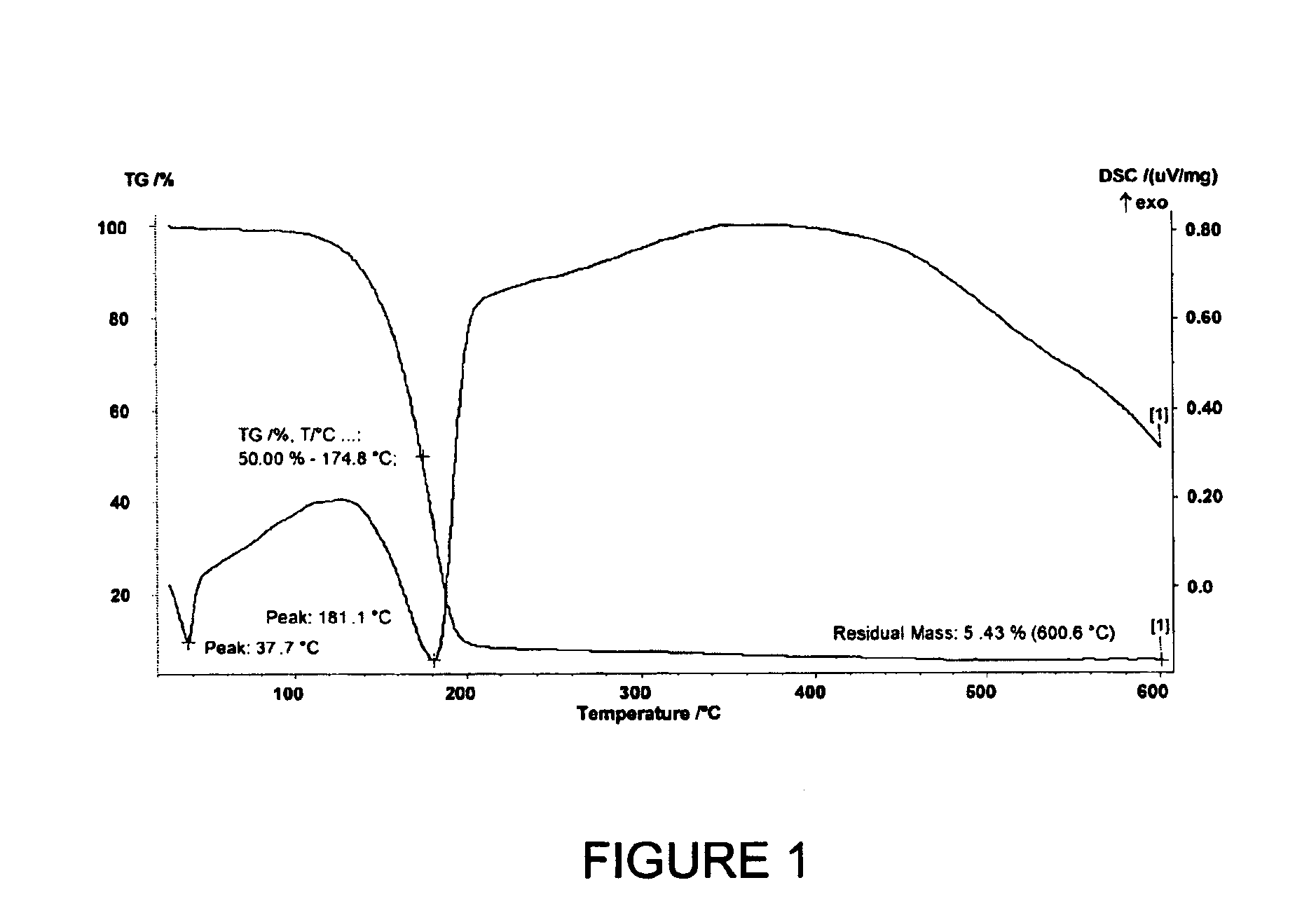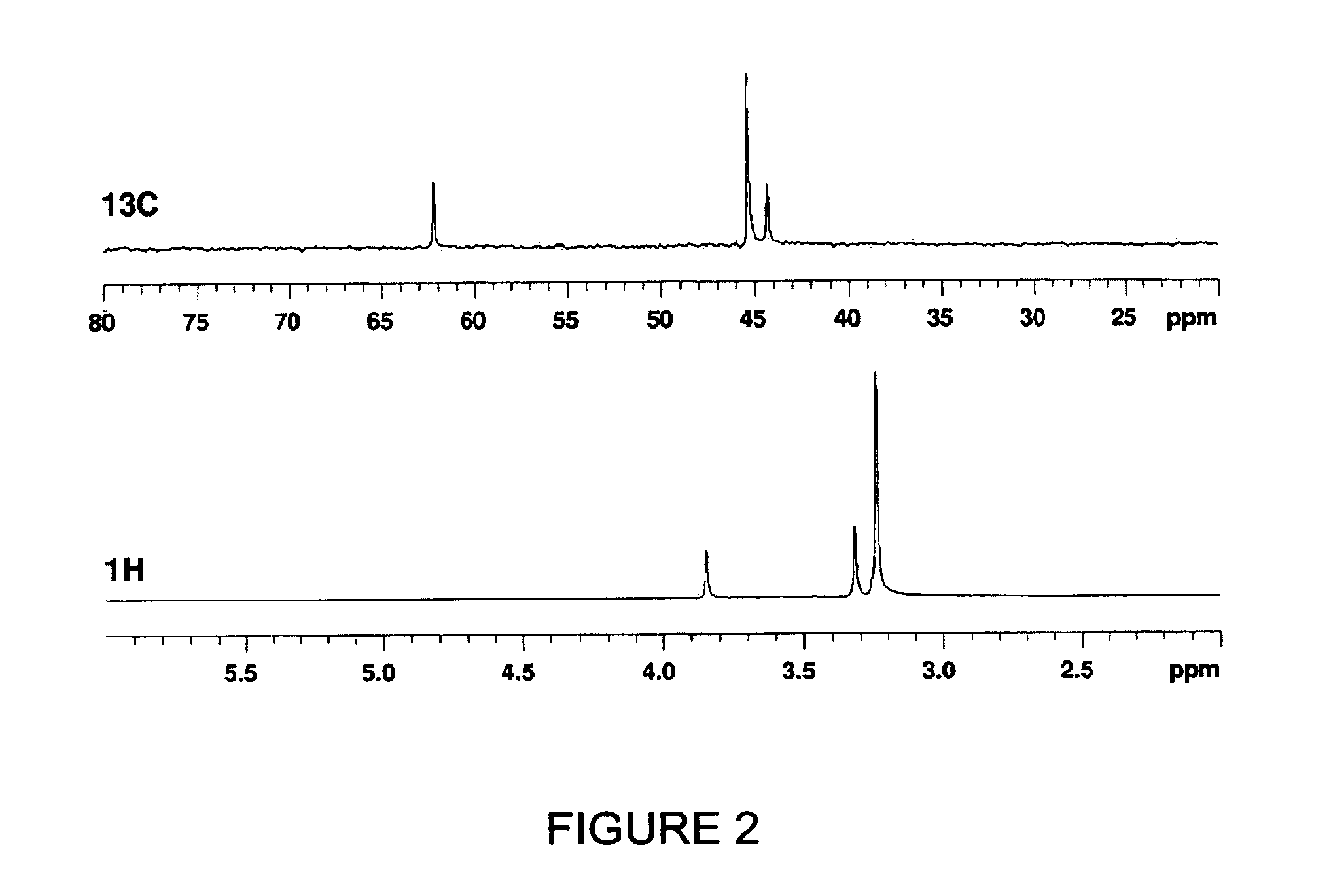Tantalum amide complexes for depositing tantalum-containing films, and method of making same
a technology of tantalum-containing films and complexes, which is applied in the field of tantalum-containing film complexes, can solve the problems of increasing the complexity and cost of the deposition system, unable to solve the problem of multiple problems, and unable to meet the requirements of the group 5/15 element organic compound,
- Summary
- Abstract
- Description
- Claims
- Application Information
AI Technical Summary
Benefits of technology
Problems solved by technology
Method used
Image
Examples
example 1
[0107]In this example, η2-N,N′-dimethylethylenediamino-tris-dimethylaminotantalum, (η2-MeN(CH2)2NMe)Ta(NMe2)3 (DEMAT), was synthesized at high purity and in good yield.
[0108]The synthesis of DEMAT was carried out using standard Schlenk techniques. 15.8 mL n-butyl lithium (1.6 M in hexanes, 0.025 mol) was added to a 100 mL Schlenk flask immersed in an ice bath and charged with 1.11 g N,N′-dimethylethylenediamine (0.013 mol) in 50 mL hexanes. White precipitation appeared after the addition started and the reaction was exothermic. The reaction mixture comprising MeNLi(CH2)2LiNMe was allowed to warm to room temperature. Next the MeNLi(CH2)2LiNMe mixture was added dropwise to 4.39 g [(MeN)3TaCl2]2 (5.71 mmol) in 100 mL hexanes at room temperature and stirred overnight. Following filtration, the dark brown filtrate was recovered. The volatiles from the filtrate were removed in vacuo at room temperature followed by vacuum distillation at 79° C. and 50 mTorr to yield 3.06 g of red orange (η...
example 2
[0111]In this example, η2-N,N′-diethylethylenediamino-tris-dimethylaminotantalum, (η2-EtN(CH2)2NEt)Ta(NMe2)3 (DEMAT), was synthesized at high purity and in good yield.
[0112]The synthesis of (η2-EtN(CH2)2NEt)Ta(NMe2)3 was carried out using standard Schlenk techniques. 13.4 mL n-butyl lithium (1.6 M in hexanes, 0.021 mol) was added to a 250 mL Schlenk flask immersed in an ice bath and charged with 1.11 g N,N′-diethylethylenediamine (0.011 mol) in 100 mL hexanes. White precipitation appeared after the addition started and the reaction was exothermic. The reaction mixture comprising EtNLi(CH2)2LiNEt was allowed to warm to room temperature. Next the EtNLi(CH2)2LiNEt mixture was added dropwise to 4.14 g [(MeN)3TaCl2]2 (5.39 mmol) in 100 mL hexanes at room temperature and stirred overnight. Following filtration, the dark brown filtrate was recovered. The volatiles from the filtrate were removed in vacuo at room temperature followed by vacuum distillation at 77° C. and 65 mTorr to yield 2.0...
example 3
[0115]In this example, η2-N,N′-dimethylpropanediamino-tris-dimethylaminotantalum, (η2-MeN(CH2)3NMe)Ta(NMe2)3, was synthesized at high purity and in good yield.
[0116]The synthesis of (η2-MeN(CH2)3NMe)Ta(NMe2)3 was carried out using standard Schlenk techniques. 16.4 mL n-butyl lithium (1.6 M in hexanes, 0.026 mol) was added to a 100 mL Schlenk flask immersed in an ice bath and charged with 1.34 g N,N′-dimethylpropanediamine (0.013 mol) in 50 mL hexanes. White precipitation appeared after the addition started and the reaction was exothermic. The reaction mixture comprising MeNLi(CH2)3LiNMe was allowed to warm to room temperature. Next the MeNLi(CH2)3LiNMe mixture was added dropwise to 5.02 g [(MeN)3TaCl2]2 (6.54 mmol) in 30 mL hexanes at room temperature and stirred and refluxed at 80° C. overnight. Following filtration, the dark brown filtrate was recovered. The volatiles from the filtrate were removed in vacuo at room temperature followed by vacuum distillation at 85° C. and 50 mTorr...
PUM
| Property | Measurement | Unit |
|---|---|---|
| temperatures | aaaaa | aaaaa |
| temperatures | aaaaa | aaaaa |
| temperature | aaaaa | aaaaa |
Abstract
Description
Claims
Application Information
 Login to View More
Login to View More - R&D
- Intellectual Property
- Life Sciences
- Materials
- Tech Scout
- Unparalleled Data Quality
- Higher Quality Content
- 60% Fewer Hallucinations
Browse by: Latest US Patents, China's latest patents, Technical Efficacy Thesaurus, Application Domain, Technology Topic, Popular Technical Reports.
© 2025 PatSnap. All rights reserved.Legal|Privacy policy|Modern Slavery Act Transparency Statement|Sitemap|About US| Contact US: help@patsnap.com



